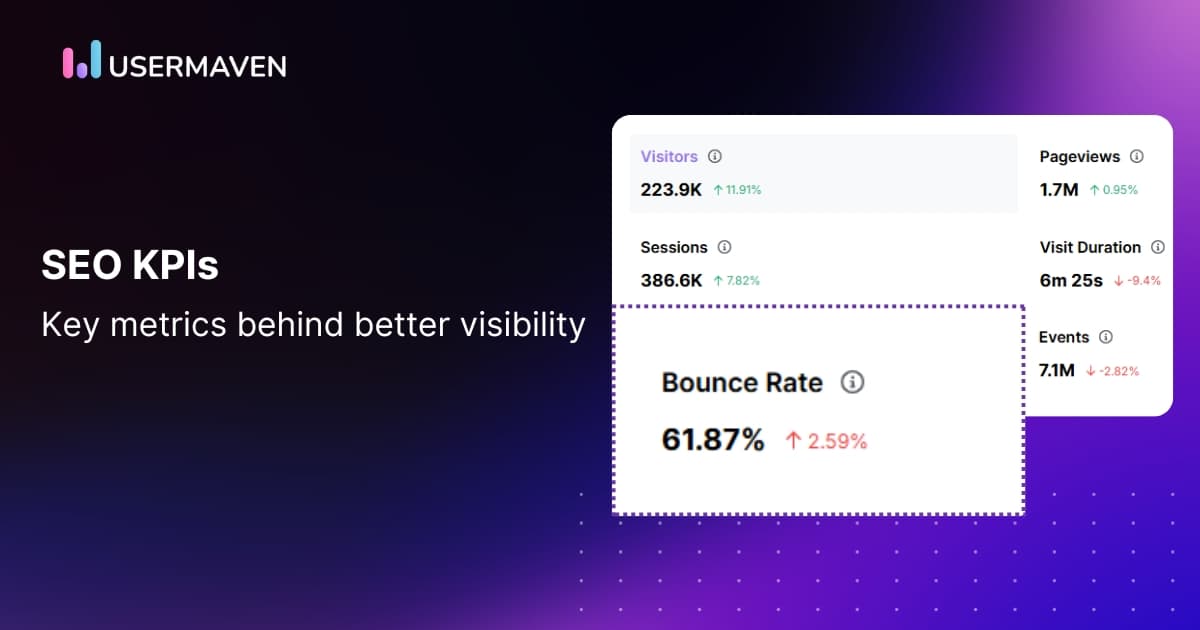Table of contents
Data-driven marketing: Optimize your strategy for growth
Aug 1, 2025
9 mins read
Written by Esha Shabbir

Marketing today can feel like wandering through a maze, where every turn leads to more questions than answers. With an overload of data and numerous platforms, it’s hard to figure out what actually works.
That’s where data-driven marketing steps in to help you cut through the noise and guide you toward what truly matters.
Data shows exactly what’s working, what’s not, and, most importantly, what your customers actually want. It’s about tuning into your customers and speaking directly to their needs, not just hoping they’ll hear your message.
With the right analytics platform, you can stop second-guessing and start seeing real results. Ready to take the guesswork out of marketing? Let’s dive in.
What is data-driven marketing?
Data-driven marketing centers on utilizing customer data to inform marketing decisions and personalize customer experience. Rather than guessing what might work, it’s about truly understanding your customers: what they enjoy, how they behave, and what drives their purchases.
By analyzing this data, businesses can craft highly personalized campaigns that resonate with their audience’s specific needs and preferences. It’s about reaching the right people with the right message at the perfect moment, almost as if you know what your customers want before they even ask for it.
So, why does this matter?
The digital revolution has transformed data into a goldmine for marketers, replacing uncertainty with informed decisions. As businesses move away from traditional, instinct-based marketing, they’re embracing data-driven marketing strategies that make every move smarter and more effective.
And the numbers speak for themselves. Companies that employ data-driven strategies achieve five to eight times more ROI than those that don’t, demonstrating that when it comes to marketing, relying on data far outweighs trusting intuition.
In today’s competitive landscape, data isn’t just a bonus; it’s the key to standing out and thriving.
Benefits of data-driven marketing
Data-driven marketing isn’t just a buzzword; it’s essential for staying competitive. By leveraging data, you can create more effective campaigns, enhance customer experiences, and achieve better results.
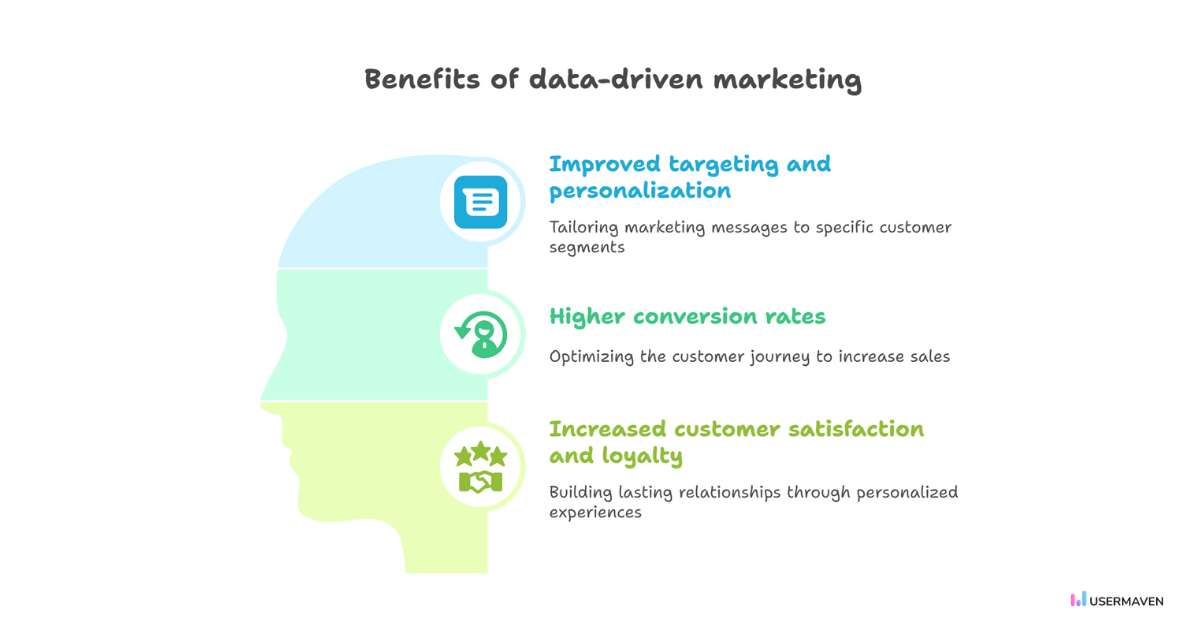
Let’s look at the key benefits that data brings to your marketing efforts.
Improved targeting and personalization
In today’s competitive landscape, a one-size-fits-all marketing approach simply doesn’t suffice anymore. With data-driven marketing, businesses can go beyond the traditional shotgun method and focus on personalization.
In fact, 73% of customers now expect better personalization as technology advances, making it even more crucial to get it right.
By analyzing customer data, such as browsing behavior, past purchases, and engagement history, businesses can segment their audience into distinct groups. This enables you to craft messages that resonate with each segment, making your marketing more relevant and personal.
Take a clothing brand, for example. Instead of promoting every product to everyone, they can target fitness enthusiasts with activewear deals and professionals with promotions for business attire. That’s the power of segmentation: reaching the right people with the right message at the right time.
The result? Higher engagement and better conversions.
By leveraging data insights, you’re no longer relying on broad, generic campaigns. You’re creating tailored experiences that address the specific needs of each customer segment, resulting in more clicks, sign-ups, and purchases.
Higher conversion rates
Converting potential customers into actual sales is the ultimate goal of any marketing strategy. Data-driven marketing enables you to track the entire conversion funnel, from the moment someone lands on your site to the point when they make a purchase.
But it doesn’t stop there. By following the customer journey, you can spot where customers drop off, whether it’s on your website, during checkout, or in a follow-up email.
Attribution models further enhance this process by revealing which channels are most effective at driving conversions. Is your email campaign outperforming your paid ads? Or is organic search bringing in the highest-quality leads? Understanding which touchpoints matter most lets you allocate your resources more effectively, ultimately improving your conversion rates and boosting ROI.
With a clear view of the customer journey and insights into user behavior, you can fine-tune every step of the process. It’s no longer just about marketing; it’s about optimizing to turn leads into loyal customers and driving real, measurable results.
Increased customer satisfaction and loyalty
Building customer satisfaction isn’t just about making a sale; it’s about turning that sale into a lasting relationship.
Customers want to feel understood, and with the right data, you can make that happen. By tracking their behavior and preferences, you can anticipate their needs and deliver offers that genuinely matter to them. For example, if a customer frequently browses running shoes on your site but hasn’t made a purchase, sending them a personalized discount or recommendation might be the nudge they need to convert.
This type of tailored experience fosters trust and encourages customers to keep coming back. The more relevant your content, the more valued your customers feel, leading to higher retention rates.
By understanding your customers deeply and delivering exactly what they want, you’re not just meeting their expectations, you’re exceeding them.
As customer satisfaction grows, so does loyalty. A solid data strategy can turn one-time buyers into repeat customers, building long-term relationships that drive sustainable growth.
Building a data-driven marketing strategy
A data-driven marketing strategy doesn’t happen overnight. It requires careful planning and execution to leverage insights that will not only boost engagement but also drive conversions.
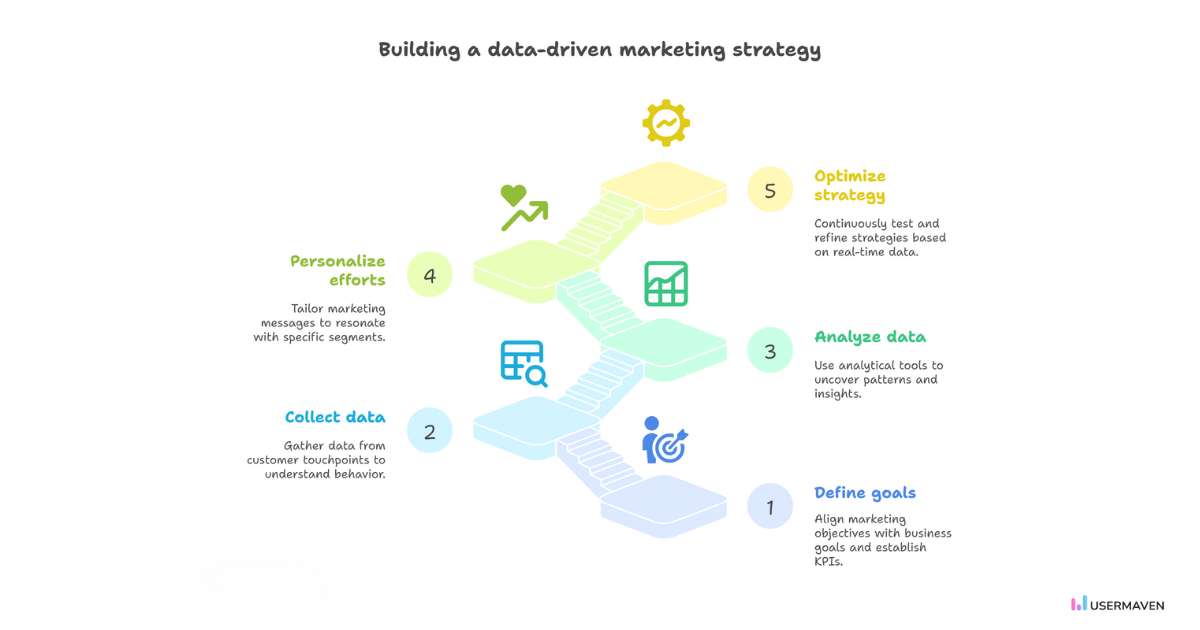
Here’s a step-by-step guide on how to build an effective data-driven marketing strategy.
Define goals and metrics
The first step in creating a data-driven marketing strategy is aligning your marketing objectives with your business goals. Whether you want to increase conversions, improve customer retention, or boost brand awareness, everything should be focused on what matters most to your business.
But here’s the catch: without clear metrics, it’s easy to lose direction. That’s where KPIs (Key Performance Indicators) come in. Think of them as your roadmap, guiding you on what’s working and where to improve.
For instance, customer acquisition cost (CAC) represents the amount spent to acquire a new customer, while lifetime value (LTV) indicates the total value a customer generates over their lifetime.
By defining these KPIs early on, you give yourself the ability to track your progress. You can measure success at each stage of your conversion funnel, from attracting visitors to converting them into loyal customers.
With the right metrics in place, you can easily identify what’s working and adjust your strategy to keep moving toward your business goals.
Collect and integrate data
With your goals now in focus, it’s time to gather data from all the key touchpoints where customers interact with your brand. Start by tracking how they behave on your website and engage with your products. This helps you pinpoint what grabs their attention and how they connect with your content and offerings.
Collecting data across these touchpoints provides a more comprehensive view of the customer journey. You can track how they move from one stage to the next: whether they’re browsing, adding products to their cart, or ready to check out.
Every bit of data from the website and product analytics helps you better understand how they’re engaging with your brand.
With this insight, you can start segmenting your audience more effectively. By recognizing different behaviors, you can target specific groups based on their interactions with your website or products. This approach enables you to tailor your strategy, whether you’re targeting potential buyers or nurturing existing customers. The key is delivering the right message at the right time for each group.
Analyze data and identify insights
Once you’ve gathered your data, it’s time to dig deeper. Analytical platforms are incredibly useful for uncovering patterns in customer behavior that might not be immediately obvious. Tools like cohort analysis and predictive analytics can help you get a sense of how different customer groups might behave down the line so that you can act ahead of the curve.
It’s also crucial to visualize the user journey. Using customer journey maps, you get a clear picture of how customers interact with your brand. This can highlight moments where things might be going wrong, such as when they get stuck or drop off. Identifying these friction points lets you optimize your conversion funnel, making it more efficient.
With these insights, you can start refining your strategies. Whether it’s adjusting your messaging, improving key touchpoints, or refining your offers, data enables you to make smarter decisions that lead to better conversions over time.
Personalize marketing efforts
With insights from segmentation and behavioral analytics, you can craft marketing campaigns that resonate deeply with your audience. By tailoring messages to the specific needs and interests of each segment, you make sure your content is both personal and relevant, reaching the right people with the right message at the right time.
Personalization goes even further. With dynamic content and targeted ads, you can tailor your messaging to a customer’s actions and their stage in the journey. For example, if someone browses but doesn’t make a purchase, you can send a tailored offer or reminder to encourage them to complete the purchase. If they’ve already made a purchase, you can suggest related products they’ll love.
This level of personalization strengthens customer relationships. When people feel understood and valued, they’re more likely to stay engaged, return, and convert. Ultimately, personalization not only boosts trust but also drives long-term results.
Optimize and iterate
Once your campaigns are live, the work doesn’t stop. In fact, that’s just the beginning. Continuous optimization is crucial to ensuring that your efforts continually improve. By leveraging real-time data and insights, you can test, measure, and adjust your campaigns to see what’s really driving results. Incorporating realistic text to speech in A/B testing for video or audio campaigns can also uncover which voice style resonates most with your audience. With tools like Powtoon Text to Video AI, creating and testing new video ideas becomes faster and more efficient.
While A/B testing and multivariate testing can be helpful, the core idea is simple: experiment with different approaches and fine-tune your messaging and strategies based on what works. You don’t need to get bogged down in complex setups. Instead, focus on iterating small changes that can lead to significant improvements over time.
Through constant analysis of customer behavior patterns, you can adjust your content, offers, and overall strategy to meet their needs more effectively. This iterative process allows you to refine your approach continuously, ensuring each campaign is better than the last.
As a result, you’ll see ongoing improvements in engagement, conversions, and overall campaign performance.
Data-driven marketing vs. traditional marketing
When it comes to marketing, the approach you choose can make all the difference. Traditional marketing and data-driven marketing each have their strengths, but they work in very different ways. Here’s a quick comparison to help highlight the key differences:
| Aspect | Traditional marketing | Data-driven marketing |
| Personalization | Broad segmentation and mass messaging. | Uses real-time data to create personalized, behavior-based messaging. |
| Segmentation | Segments by basic demographics. | Segments based on detailed actions, past purchases, and behavior. |
| Real-time insights | Feedback is slow; campaigns, such as print ads, take time to evaluate. | Provides immediate insights for quick adjustments and real-time optimization. |
| Data utilization & ROI | Relies on intuition and historical data, making ROI measurement more challenging. | Tracks every customer action, providing clear ROI insights across the journey. |
| Targeting & reach | Aims for a broad reach with limited targeting (e.g., TV ads, billboards). | Focuses on precise targeting based on customer behavior and demographics. |
| Budget considerations | Suitable for mass campaigns, but lacks control over budget and performance tracking. | Offers better control over budget allocation and performance measurement. |
| When to choose | Best for mass awareness campaigns, especially in broad industries. | Essential for precise targeting and measurable outcomes, ideal for niche markets. |
Different industries have different marketing needs. While some benefit from broad, mass-market tactics, others thrive on more targeted, personalized approaches.
For example, industries like consumer goods often rely on traditional marketing methods. TV ads, radio spots, and billboards remain highly effective for quickly reaching a broad audience.
These large-scale campaigns are ideal for brands seeking to establish awareness and gain visibility across diverse demographics. When the goal is visibility, these tried-and-true methods are hard to beat.
But for industries like tech or SaaS, things are a little different. These industries thrive when they can dive deeper into customer behavior and preferences. This is where data-driven marketing really comes into play. By analyzing customer data, brands can create personalized and relevant experiences that directly address their audience’s needs.
Data-driven marketing strategies help businesses understand what their customers truly want, allowing them to tailor their marketing efforts in a more meaningful way. With the right insights, campaigns become more efficient, impactful, and engaging.
Ethical considerations in data-driven marketing
How you handle customer data can directly affect trust, brand reputation, and even legal compliance. That’s why it’s crucial to approach data-driven marketing with ethics at the forefront, ensuring that you protect your customers’ privacy while delivering valuable, personalized experiences.
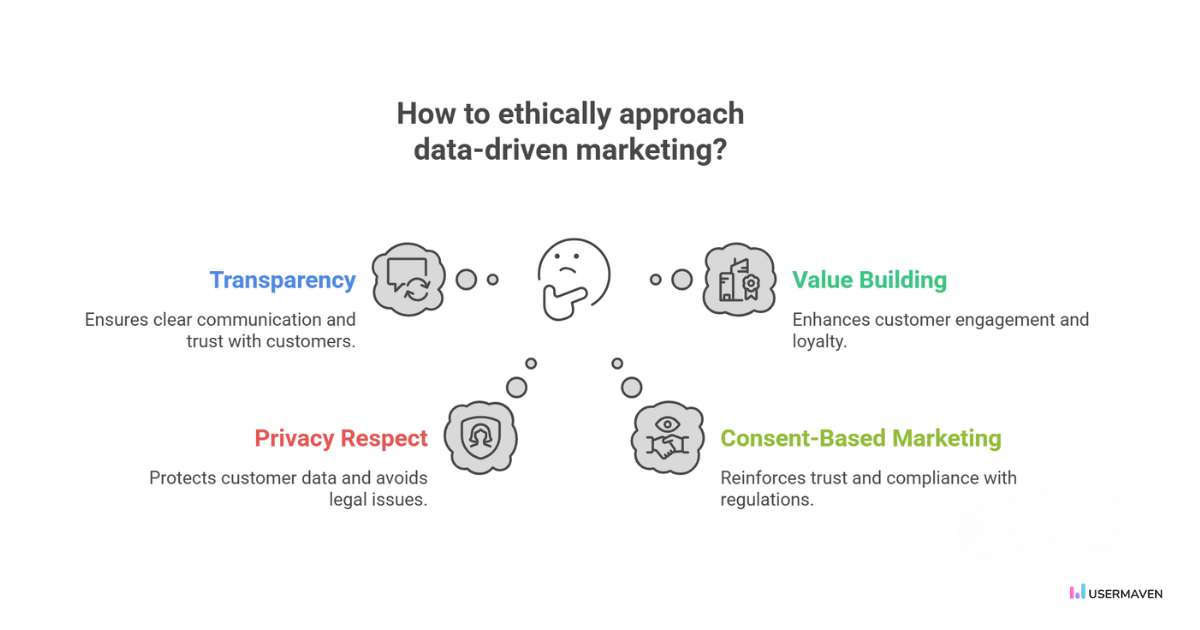
Transparency
- Clear data collection practices: Communicate what data is being collected, why it’s needed, and how it will be used.
- Easy opt-in and opt-out options: Allow users to quickly manage their data preferences and choose when they want to engage with your brand.
- Robust data security measures: Implement strong measures to protect user data from unauthorized access and breaches, ensuring customer trust.
Focus on building value
- Personalization without intrusion: Use data to personalize experiences, but avoid any practices that feel invasive or uncomfortable for customers.
- Offer value in exchange for data: Provide meaningful content, exclusive offers, or practical experiences in return for customer data.
- Build genuine relationships: View data as a tool to better understand your audience, enabling you to create lasting, meaningful connections.
Respect user privacy
- Minimize data collection: Collect only the data necessary for your marketing objectives and avoid gathering excessive information.
- Set clear data retention policies: Define how long user data will be stored and when it will be securely deleted.
- Comply with data privacy regulations: Stay current with laws like GDPR and CCPA to avoid legal risks and demonstrate a commitment to protecting customer data.
Embrace consent-based marketing
- Obtain explicit consent: Always secure clear permission before collecting or using customer data.
- Provide a simple way to withdraw consent: Allow customers to easily update their preferences or withdraw consent at any time.
- Respect user choices: Always honor customers’ preferences around data collection and communication, reinforcing trust and transparency in your brand.
How Usermaven helps with data-driven marketing
When it comes to data-driven marketing, having the right tools is crucial. Usermaven is an all-in-one platform that helps you track, analyze, and optimize your customer journey, turning raw data into meaningful insights.
Here’s how it can help you level up your marketing efforts.
Real-time dashboards
Usermaven’s real-time dashboards enable faster and more effective decision-making. No more waiting for weekly reports or relying on outdated data to guide your marketing efforts.
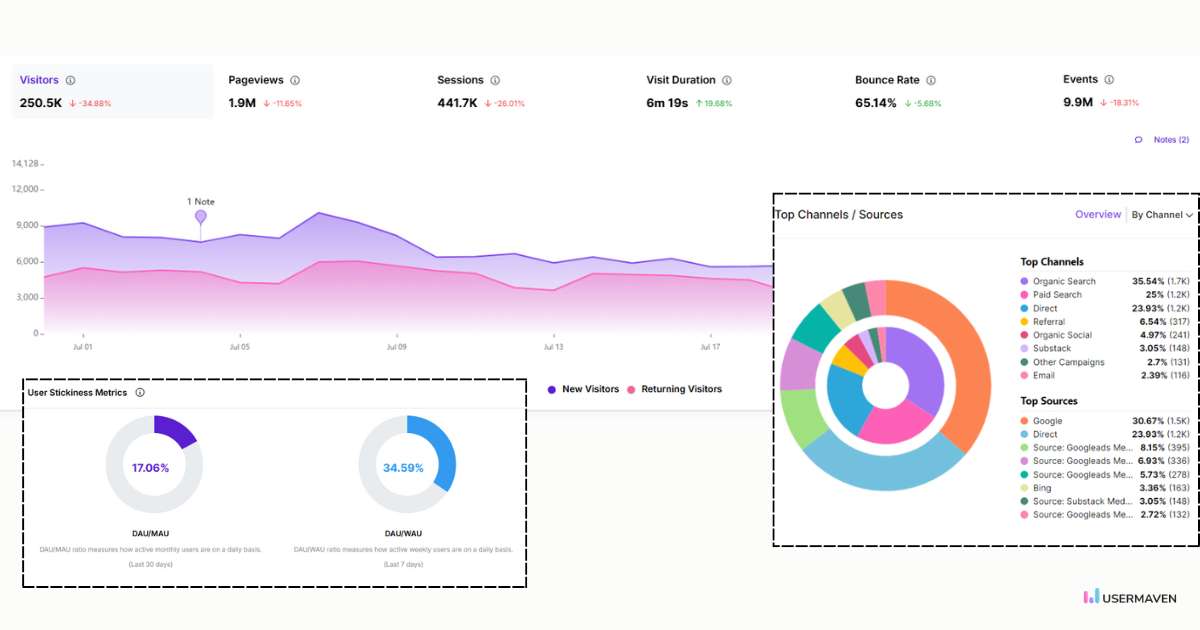
With instant visibility on everything, from conversions and customer behavior to campaign performance, you’ll always know how your strategies are working, right in the moment.
This level of immediacy allows you to adjust your strategies spontaneously, making data-driven decisions that directly impact your results. It also ensures you’re always working with the freshest data, keeping you agile in a fast-paced market.
Whether you’re tracking engagement trends or evaluating campaign success, these real-time insights keep you informed at every stage of the process. This kind of transparency and control offers a competitive edge that’s hard to match.
Segments
With Usermaven’s segments, you can connect with customers in a more meaningful way. Rather than using broad, one-size-fits-all strategies, you can tailor your messaging to specific groups based on behavior, preferences, and interactions.
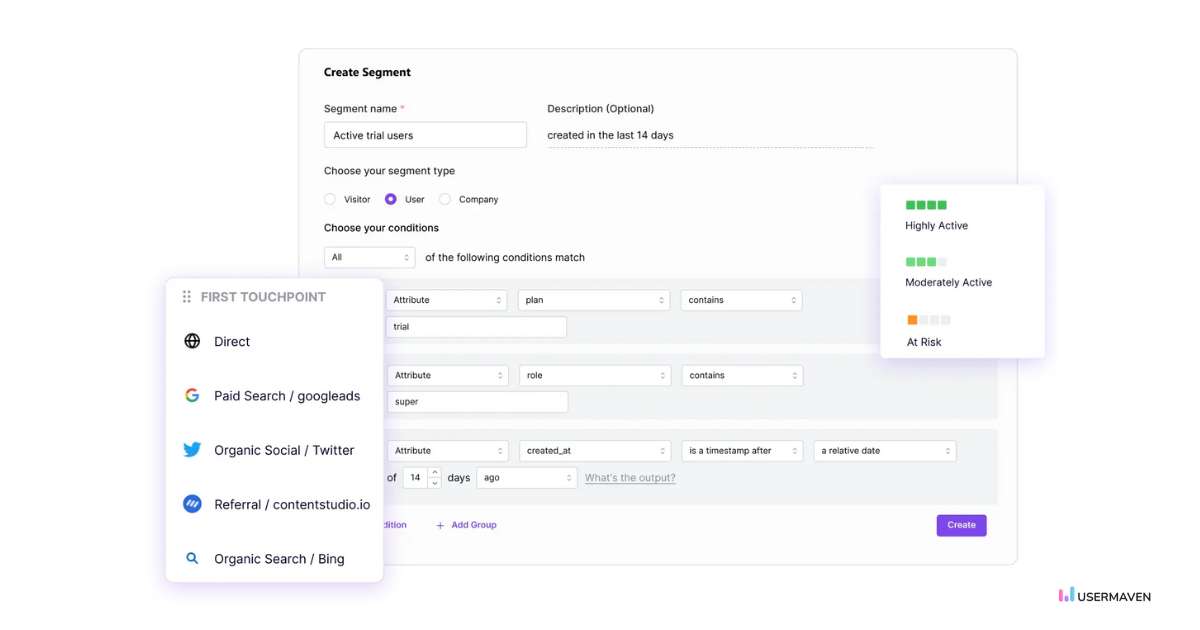
Whether you’re targeting first-time visitors, repeat buyers, or users who have abandoned their carts, this precise segmentation ensures every message is relevant and timely.
This isn’t just about personalization: it’s about increasing engagement and conversions. By delivering the right content to the right person at the right time, you create dynamic campaigns that speak directly to your audience’s needs. It’s a powerful way to strengthen customer relationships and drive results.
Funnels
Usermaven’s funnel tracking gives you a detailed view of how users navigate your website or app. You’ll get valuable insights into every step of their journey, from initial interest to final purchase. With this information, you can pinpoint where users drop off, get stuck, or abandon the process altogether.
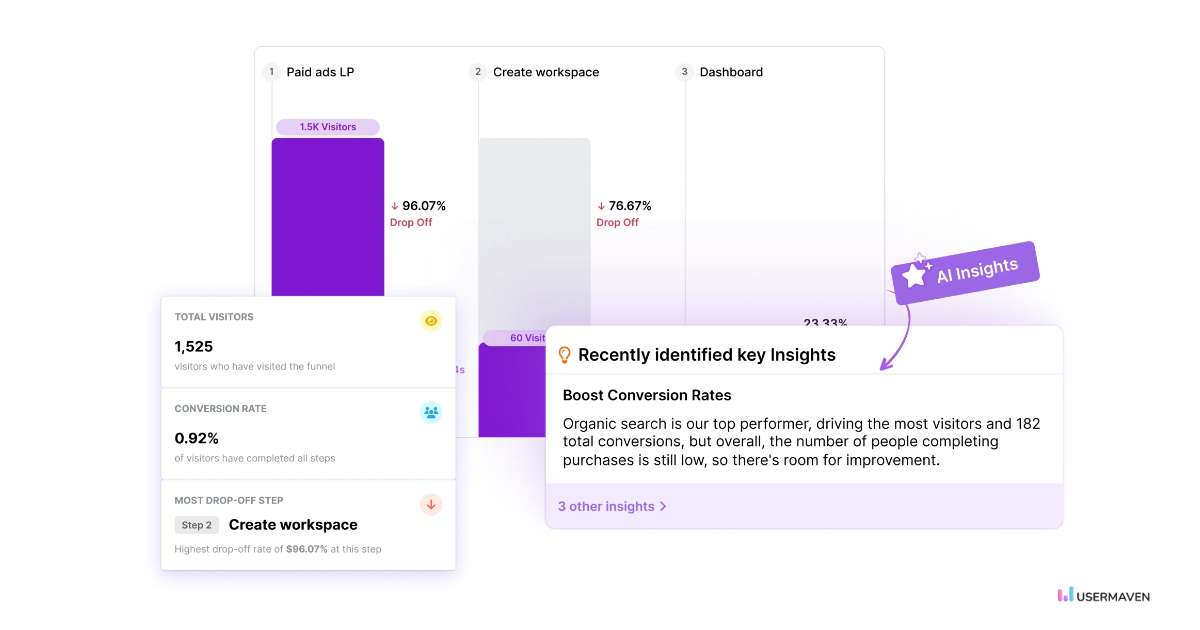
The real power here is in the ability to optimize your funnels. By identifying pain points, you can remove barriers that hinder conversion, making your process smoother and more effective. These actionable insights allow you to refine your strategy, boosting conversions and enhancing the overall user experience.
User journeys
Understanding how customers interact with your brand across multiple touchpoints is essential for refining your marketing strategy. Usermaven’s user journey tracking makes this easy by visualizing how users move through your website.
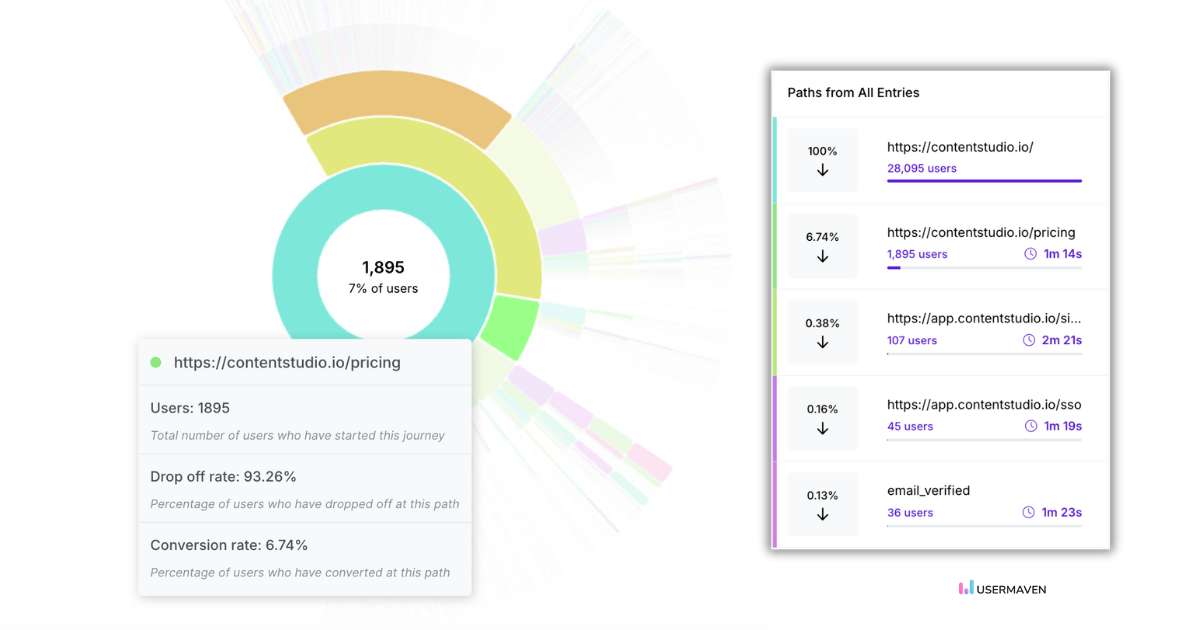
You’ll see which pages they visit, what content they engage with, and how they interact with your brand. This visibility lets you adjust your messaging, refine content, and make strategic offers that guide users smoothly through their journey. With this level of insight, you can develop strategies that are directly aligned with user behavior, resulting in higher conversion rates.
Cohort analysis
Usermaven’s cohort analysis helps you understand customer behavior over time by grouping users into cohorts based on shared characteristics. This allows you to track how different segments engage with your brand at various stages, providing a deeper understanding of retention and loyalty.
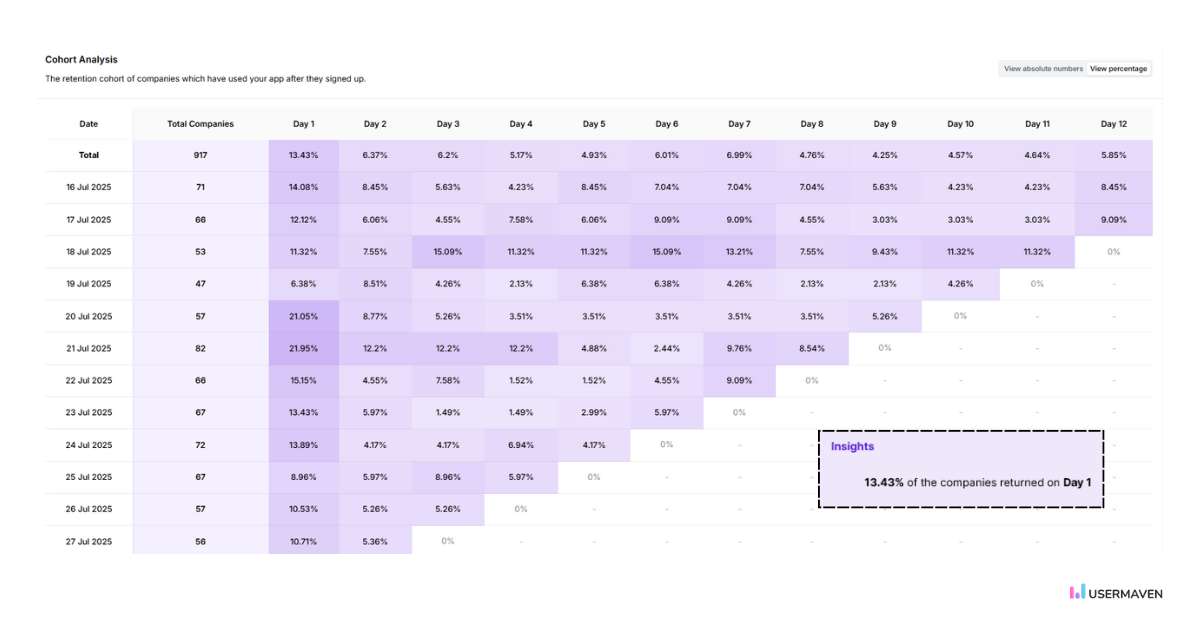
By uncovering trends and patterns, you can make informed decisions to nurture long-term relationships and boost retention.
Whether you’re turning first-time buyers into repeat customers or building stronger brand loyalty, cohort analysis helps you optimize your efforts for sustained growth.
Usermaven makes data-driven marketing easier than ever. With automatic event tracking and a user-friendly interface, there’s no need for technical expertise or developer support. This means you can focus on what really matters: optimizing campaigns and making informed decisions.
The platform’s seamless integration of real-time insights, segmentation, and other powerful features allows marketers and product professionals to maximize their efforts without the usual complexity of traditional tools.
If you’re looking to streamline your analytics and see better results, Usermaven is the ideal solution.
Conclusion: Unlocking the power of data in marketing
Marketing doesn’t have to be a guessing game. With data-driven strategies, you can make informed decisions based on real customer insights, rather than relying on hunches.
With the right data in hand, you can identify your ideal audience, craft personalized experiences, and track the effectiveness of your efforts. It’s all about sharpening your strategy and making every move count, all while staying in tune with your customers’ needs.
Think of data-driven marketing as your ultimate tool for transformation. It gives you the flexibility to adapt, evolve, and create a roadmap for long-term growth. Platforms like Usermaven make this process seamless, helping you track user behavior and make smarter decisions that drive real results.
So, why settle for guesswork when data can help you craft smarter, more impactful strategies?
FAQs about data-driven marketing
1. Why is data-driven marketing more effective than traditional methods?
Data-driven marketing outperforms traditional methods by replacing broad assumptions with real-time insights. While traditional marketing relies on mass outreach and guesswork, data-driven strategies deliver personalized, timely messages to the right audience, resulting in better engagement, optimized resources, and continuous improvement. This makes it more adaptable and impactful.
2. How can data-driven marketing improve my ROI?
Data-driven marketing enables you to transition from broad, one-size-fits-all strategies to highly targeted campaigns based on actual customer behavior. By understanding your customers’ preferences and actions, you can deliver the right message at the right time. This increases engagement, reduces wasted ad spend, and optimizes conversion rates, ultimately driving a higher return on investment.
3. How can analytics platforms help improve data-driven marketing strategies?
The right analytics platform can transform raw data into actionable insights, enabling businesses to optimize their marketing efforts. For example, platforms like Usermaven allow for real-time tracking and segmentation, making it easier to personalize marketing strategies based on customer behaviors and preferences. These insights enable businesses to refine their campaigns, enhance targeting, and achieve better results without relying on guesswork.
Try for free
Grow your business faster with:
- AI-powered analytics & attribution
- No-code event tracking
- Privacy-friendly setup


